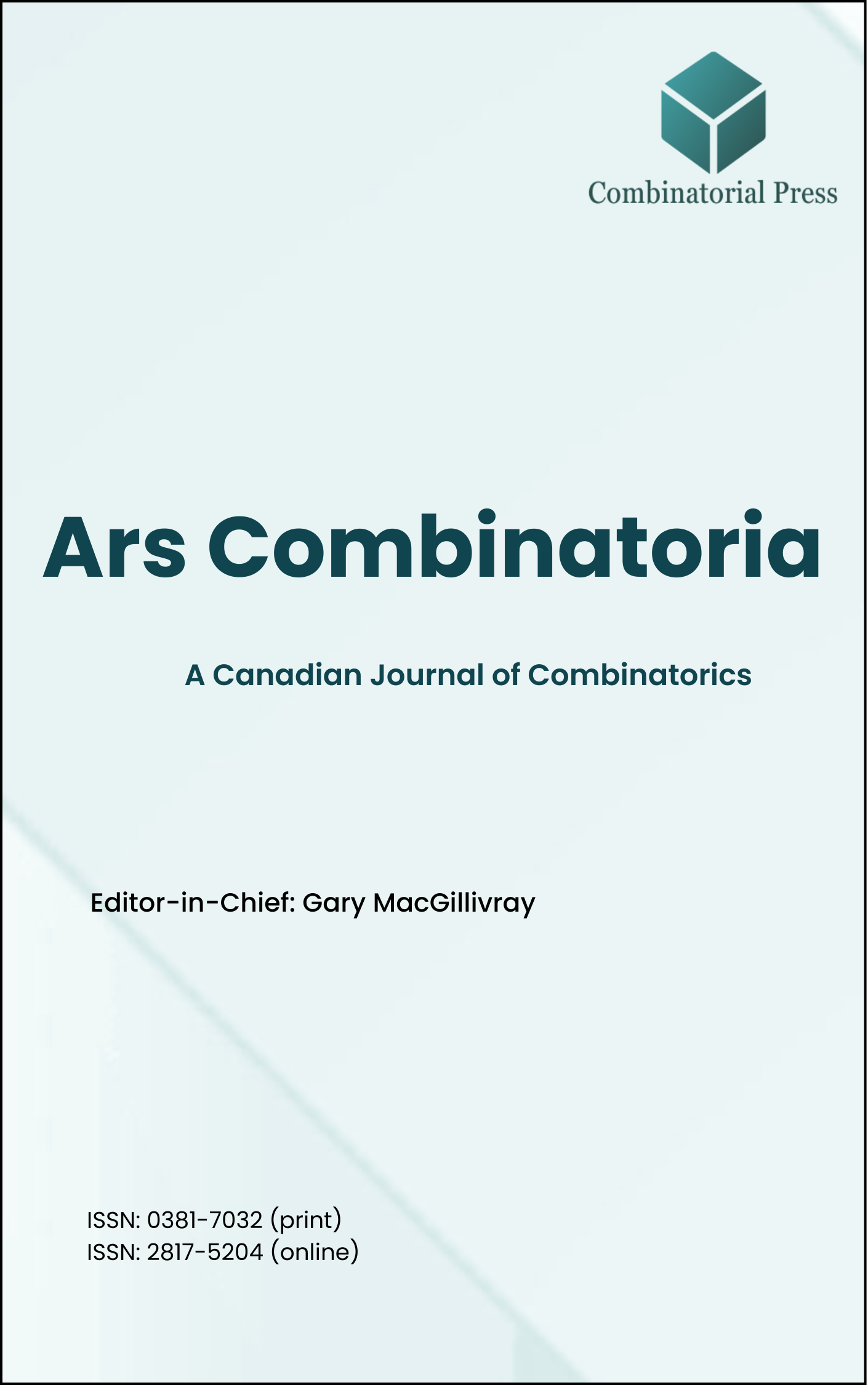
Ars Combinatoria
ISSN 0381-7032 (print), 2817-5204 (online)
Ars Combinatoria is the oldest Canadian Journal of Combinatorics, established in 1976. The journal is dedicated to advancing the field of combinatorial mathematics through the publication of high-quality research papers. From 2024 onward, it publishes four volumes per year in March, June, September and December. Ars Combinatoria has gained recognition and visibility in the academic community and is indexed in renowned databases such as MathSciNet, Zentralblatt, and Scopus. The Scope of the journal includes Graph theory, Design theory, Extremal combinatorics, Enumeration, Algebraic combinatorics, Combinatorial optimization, Ramsey theory, Automorphism groups, Coding theory, Finite geometries, Chemical graph theory but not limited.
Information Menu
- Research article
- Full Text
- Ars Combinatoria
- Volume 035
- Pages: 161-171
- Published: 30/06/1993
- Research article
- Full Text
- Ars Combinatoria
- Volume 035
- Pages: 151-159
- Published: 30/06/1993
Let \(T_{g}(m,n)\) (respectively, \(P_{g}(m, n)\)) be the number of rooted maps, on an orientable (respectively, non-orientable) surface of type \(g\), which have \(m\) vertices and \(n\) faces. Bender, Canfield and Richmond [3] obtained asymptotic formulas for \(T_{g}(m,n)\) and \(P_{g}(m,n)\) when \(\epsilon \leq m/n \leq 1/\epsilon\) and \(m,n \to \infty\). Their formulas cannot be extended to the extreme case when \(m\) or \(n\) is fixed. In this paper, we shall derive asymptotic formulas for \(T_{g}(m,n)\) and \(P_{g}(m,n)\) when \(m\) is fixed and derive the distribution for the root face valency. We also show that their generating functions are algebraic functions of a certain form. By the duality, the above results also hold for maps with a fixed number of faces.
- Research article
- Full Text
- Ars Combinatoria
- Volume 035
- Pages: 143-150
- Published: 30/06/1993
Consider the following two-person game on the graph \(G\). Player I and II move alternatingly. Each move consists in coloring a yet uncolored vertex of \(G\) properly using a prespecified set of colors. The game ends when some player can no longer move. Player I wins if all of \(G\) is colored. Otherwise Player II wins. What is the minimal number \(\gamma(G)\) of colors such that Player I has a winning strategy? Improving a result of Bodlaender [1990] we show \(\gamma(T) \leq 4\) for each tree \(T\). We, furthermore, prove \(\gamma(G) = O(\log |G|)\) for graphs \(G\) that are unions of \(k\) trees. Thus, in particular, \(\gamma(G) = O(\log |G|)\) for the class of planar graphs. Finally we bound \(4(G)\) by \(3w(G) – 2\) for interval graphs \(G\). The order of magnitude of \(\gamma(G)\) can generally not be improved for \(k\)-fold trees. The problem remains open for planar graphs.
- Research article
- Full Text
- Ars Combinatoria
- Volume 035
- Pages: 135-142
- Published: 30/06/1993
We examine properties of a class of hypertrees, occurring in probability, which are described by sequences of subscripts.
- Research article
- Full Text
- Ars Combinatoria
- Volume 035
- Pages: 129-134
- Published: 30/06/1993
We give, among other results, a new method to construct for each positive integer \(n\) a class of orthogonal designs \( {OD}(4^{n+1};m;4^n m,4^n m,4^n m,4^n m)\), \(m=2^a 10^b 26^c +4^n+1\), \(a,b,c\) non-negative integers.
- Research article
- Full Text
- Ars Combinatoria
- Volume 035
- Pages: 125-127
- Published: 30/06/1993
We verify that \(6\) more of the tum squares of order \(10\) cannot be completed to a triple of mutually orthogonal Latin squares of order \(10\). We find a pair of orthogonal Latin squares of order \(10\) with \(6\) common transversals, \(5\) of which have only a single intersection, and a pair with \(7\) common transversals.
- Research article
- Full Text
- Ars Combinatoria
- Volume 035
- Pages: 123-124
- Published: 30/06/1993
- Research article
- Full Text
- Ars Combinatoria
- Volume 035
- Pages: 117-122
- Published: 30/06/1993
We give a complete solution to the existence problem for subdesigns in complementary \(\mathrm{P}_3\)-decompositions, where \(\mathrm{P}_3\) denotes the path of length three. As a corollary we obtain the spectrum for incomplete designs with block size four and \(\lambda = 2\), having one hole.
- Research article
- Full Text
- Ars Combinatoria
- Volume 035
- Pages: 103-115
- Published: 30/06/1993
In this paper, we give some recursive constructions for large sets of disjoint group-divisible designs with block size \(3\). In particular, we construct new infinite classes of large sets for designs having group-size two. These large sets have applications in cryptography to the construction of perfect threshold schemes.
- Research article
- Full Text
- Ars Combinatoria
- Volume 035
- Pages: 97-102
- Published: 30/06/1993
A decomposition into non-isomorphic matchings, or \(DINIM\) for short, is a partition of the edges of a graph \(G\) into matchings of different sizes. As a special case of our results, we prove that if a graph \(G\) has at least \((2\chi’ – 2)\chi’ + 1\) edges, where \(\chi’ = \chi'(G)\) is the chromatic index of \(G\), then \(G\) has a \(DINIM\). In particular, the \(n\)-dimensional cube, \(Q_n\), \(n \geq 4\), has a \(DINIM\). These results confirm two conjectures which appeared in Chinn and Richter [3].





